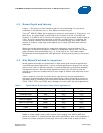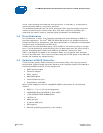
Intel
SSD DC S3500 Workload Characterization in RAID Configurations
White Paper December 2013
16 329903-001US
Figure 8. RAID 5 Random 90% Read @ 4KB Transfer Size with
Average Latency
Intel internal testing, October 2013
Figure 9. RAID 5 Random 100% Read @ 4KB Transfer Size with
Average Latency
Intel internal testing, October 2013
Notes:
Figures 7, 8, 9 - As the workloads become more read intensive, there is a steady increase in
performance both as drives are added and as the queue deepens.
Figures 7, 8, 9 – As read percentage increases, the exponential increase in latency is not as
prominent with deeper queues. This is due to the speed at which reads are performed.
6.3 RAID 5 Consistency
Consistency behind a RAID controller is very important because the performance of any
RAID set is limited by the lowest performing drive. As the number of different drives in a
RAID set increases, so does the likelihood of any given drive performing poorly.
Therefore, if the model of drive used is inconsistent in its performance, the inconsistency
increases with the size of the RAID set.
The Intel
®
SSD DC S3500 Series drive has shown excellent consistency when used as a
single drive. Figure 10 illustrates that the DC S3500 is also very consistent in RAID sets.
The three-drive and eight-drive data shows the maximum latency is grouped very
tightly; indicating that adding more drives would have little impact on consistency.


















